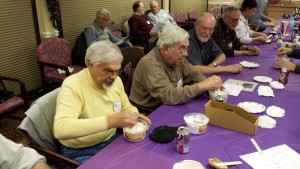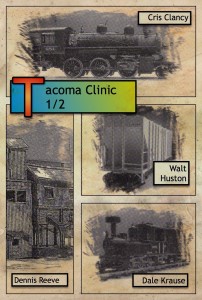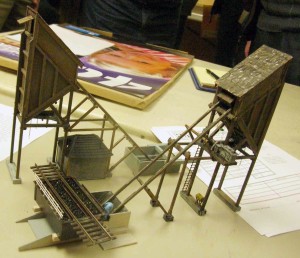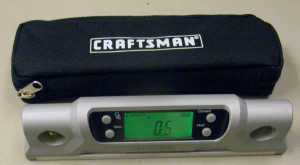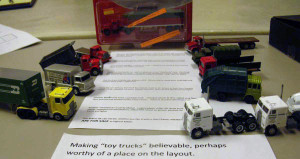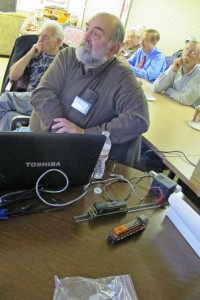By Jeff Moorman
Please join us for our next meeting on Thursday, February 6, 2014. Our guest speaker will be a railroad engineer. Not an engine driver, but a civil engineer who works on local 12 inch to the foot scale railroad projects. I have also been told he is an excellent railroad photographer and we may see some of his work, if there is time.
As I write this another Pacific Science Center Model Railroad Show has been completed. As near as we can tell, this was the 40th such show and if you were there to help on Saturday, you might have gotten a piece of the delicious anniversary cake. My personal thanks to all the Seattle-North Clinic attendees who came to the show to volunteer, especially Bobj, Dennis T, Norm C, Michael, and anyone whose name I missed.
I apologize for not getting a notice in the Grab Iron about our January clinic. I could not get the blog to upload my submission. And it was not just me as others had the same problem. As luck would have it, it did not clear up until after the clinic. So, I’ll include that write-up towards the end of this column
The missing notice and some wicked colds (flu?) going around thinned our ranks for the January meeting. The latter even got our guest speaker. Regardless the evening turned out rather interesting, which is often the case when you get a few experienced model railroaders together.
Roger F had brought several HO gauge locomotives that he was thinning from his collection. Much of the evening went like this:
- Roger would say a few words about a particular locomotive and sometimes how he acquired it.
- Folks around the table would chime in with what they knew about that locomotive, the railroad it ran on, and/or the model’s manufacturer.
- Cycle back to the first step above for the next locomotive.
Roger is an eclectic collector and so was the discussion. All the old dogs learned a new thing or two during the course of the discussions.
For January’s show and tell Dennis T brought along an N scale model of an electric locomotive. It was painted for the Pennsy, but likely had European origins, which no one could precisely identify. But that was not what made it so interesting. Dennis had re-motored it by cannibalizing a motor from a more recent diesel model.
Now for what happened at December’s meeting. Our own Dennis T discussed the installation of DCC decoders. This was not how to plug a decoder into a DCC-ready locomotive, but how to install one in an older locomotive that wasn’t designed for one. And, as if that wasn’t difficult enough, he did it in N scale.
Dennis started with the premise that a successful decoder installation starts with finding the right decoder. He outlined a 6-step process for this:
- The right fit – you have to find a decoder that will fit within the locomotive, whether in an existing space or space you “carve” out for it.
- The right current draw – the decoder needs to be able to handle the current the motor will need. Older motors may draw significantly more current than newer ones. However, the more current a decoder must handle, the larger the decoder must be. You may have to do a little testing on your locomotive first to see what it draws.
- Motor control – this is not so much a function of the decoder, but an analysis of whether or not you can electrically isolate the motor from the frame and run power from the tracks to the decoder and then to the motor.
- Lighting functions – so you need to do more than just control the headlights. If so, you need a decoder designed to handle more than the basics.
- Sound – sound adds another element of realism, but it takes room to install the speaker, which must be in a sealed enclosure to work property. The bigger the speaker, the better the sound. According to Dennis, the sound you get from an N scale speaker is not worth the effort to shoehorn it into a space not made for it.
- Use you resources – there is a ton of information on the web regarding DCC, decoders, and decoder installation. Do your homework. Very likely it will prevent you from making a mistake (or two, or three).
Dennis then walked through a typical decoder installation, using examples he had done. He said not to be intimidated, if you need to remove some of the locomotive weight to make room for the decoder or the wiring. You can do it with simple files and a motor tool. Just remove the weight from the chassis and “whittle” it away slowly and carefully.
Dennis ended with a couple of tips. One was to try and test as you go. For example, if it doesn’t run after everything is put together, how do you know the issue was not caused by putting the shell back on the locomotive? And, you did remember to test everything thoroughly before you took it apart to add the decoder, right? Another tip was to make sure to insulate all the wiring, using Teflon tape or heat shrink tubing.
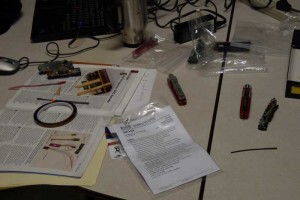
Everyone was reminded of the need for volunteers to help with the upcoming Pacific Science Center Model Railroad Show on the 18th, 19th, and 20th of January, 2014. This will be the fortieth such show and so some may take it for granted. But don’t forget it helps fund the activities of the Fourth Division, including this clinic.
For show and tell Chris F brought another HO passenger car he had acquired. Chris explained he was not just trying to paint these in UP colors, but to paint Milwaukee Road cars in UP colors as used on certain long haul passenger trains. This month he brought an observation car factory painted for the UP. His plan had been to remove the UP lettering, leaving the UP colors, and apply Milwaukee lettering. He was able to carefully remove the lettering, but in doing so discovered that the underlying paint job wasn’t up to his standards, so will now need to be repainted – exactly what he was trying not to do.
Bob R brought several commercial trucks in HO scale. These were simple toy trucks he had reworked to make more prototypical and, therefore, more useful on a model railroad layout. Bob thought that mud flaps were one addition that really made all these trucks more realistic. Another key “upgrade” was to weather the cargo area of dump and flatbeds. Other additions included mirrors, air filters, and painted on lights.
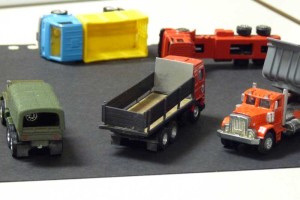

We meet at the Ronald United Methodist Church, 17839 Aurora Avenue North, Shoreline, WA. That is on the west side of Aurora (State Route 99) between 175th and 185th Streets and more specifically, between the Cadillac dealer on the south and Deseret Industries to the north. Going southbound on Aurora, make a right-hand turn into the church driveway immediately after passing the Deseret location. The parking lot is at the rear of the church. For regular meetings enter the lower, left side of the church from the rear lot.
Meetings are the first Thursday of each month, September through June. However in June we often do something different, like a layout tour. Doors open around 7:00 PM and the program starts at 7:30.
Remember the next meeting is February 6. The meeting after that is March 6. Hope to see you there or at least sometime on down the line.

